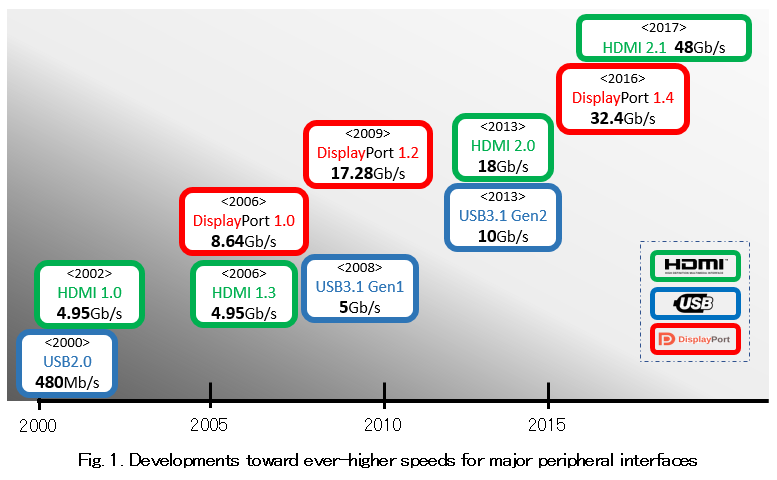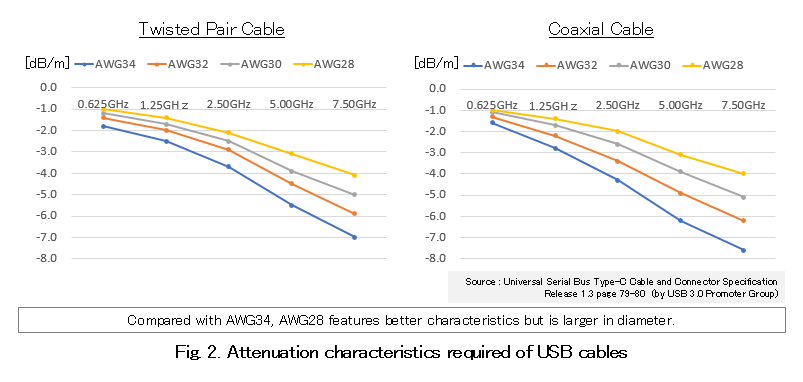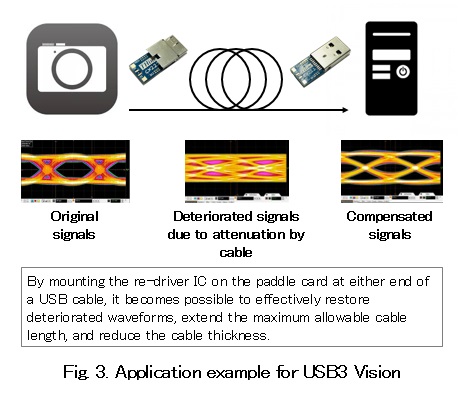THine Value Increases in the speed of USB, HDMI and DisplayPort show no signs of stopping -- Greater benefits to users, but at the cost of reduced transfer distance
2020.05.15
- Article
- Column
Today, peripheral interfaces such as USB, HDMI and DisplayPort are becoming increasingly capable of supporting higher speeds at a high pitch. Massive increases in the quantity of data and other factors lie behind such development. With increased speed, the amount of data that can be transferred increases significantly. The benefits of this speedup are enormous. On the other hand, some applications are burdened with issues due to such speedup. The most notable one is the reduced maximum distance of allowable transmission. This article describes the current state of affairs regarding the speedup of peripheral interfaces, the issues caused by reduced transfer distance, and ways to cope with such issues.
Increasingly faster peripheral interfaces
The purpose of peripheral interfaces is to enable connection between a computer and peripheral devices. The speed of such interfaces has grown rapidly (Fig. 1)

There are a variety of peripheral interfaces. Among these interfaces, the most representative one may be the Universal Serial Bus (USB), which is used for making connections to storage devices such as HDDs, SSDs and USB memories, as well as to a keyboard, mouse and printer. USB 3.1 Gen1 (originally dubbed USB 3.0) standardized in 2008 offered a data transfer rate of 5 Gbps. USB 3.1 Gen2 standardized in 2013 doubled the rate to 10 Gbps.
In the same vein, the High Definition Multimedia Interface (HDMI) for connecting between a computer and a DVD/Blu-Ray player, as well as between video playback equipment such as a set-top box and a display or projector has achieved greater speed at an increasingly rapid pace. HDMI 2.0 standardized in 2013 offered a data transfer rate of 18 Gbps (6 Gbps x 3 lanes). In 2017 or just four years later, HDMI 2.1 was released and offered a much higher rate of 48 Gbps (12 Gbits x 4 lanes).
DisplayPort is another type of interface designed to make connections between computers and displays. The latest standard "DisplayPort 1.4" formulated in 2016 features an increased rate of 32.4 Gbps (8.1 Gbps x 4 lanes).

There are a variety of peripheral interfaces. Among these interfaces, the most representative one may be the Universal Serial Bus (USB), which is used for making connections to storage devices such as HDDs, SSDs and USB memories, as well as to a keyboard, mouse and printer. USB 3.1 Gen1 (originally dubbed USB 3.0) standardized in 2008 offered a data transfer rate of 5 Gbps. USB 3.1 Gen2 standardized in 2013 doubled the rate to 10 Gbps.
In the same vein, the High Definition Multimedia Interface (HDMI) for connecting between a computer and a DVD/Blu-Ray player, as well as between video playback equipment such as a set-top box and a display or projector has achieved greater speed at an increasingly rapid pace. HDMI 2.0 standardized in 2013 offered a data transfer rate of 18 Gbps (6 Gbps x 3 lanes). In 2017 or just four years later, HDMI 2.1 was released and offered a much higher rate of 48 Gbps (12 Gbits x 4 lanes).
DisplayPort is another type of interface designed to make connections between computers and displays. The latest standard "DisplayPort 1.4" formulated in 2016 features an increased rate of 32.4 Gbps (8.1 Gbps x 4 lanes).
Triggered by increases in data quantity
Behind such speedup for peripheral interfaces lie increases in the quantity of data. Taking the number of pixels of digital single-lens reflex cameras as an example, fast-selling models and flagship models began topping 30 million pixels and 50 million pixels, respectively. The larger the pixel count, the greater the quantity of image data per picture. In the case of a 50-million pixel model, a single picture in RAW data format may amount to 60 MB. Even when this picture is compressed in JPEG format, the amount of data exceeds approximately 17 MB.
Moreover, it is a rare case where only one picture is taken. Usually, a number of pictures may be taken on one occasion. In some cases, several hundred shots may be taken. In such cases, the amount of image data can total several tens of gigabytes. When using a 480 Mbps interface in compliance with the USB 2.0 standard, data transfer alone will take many hours. This is where USB 3.0 Gen1/Gen2 comes in.
On the other hand, we cannot overlook the ongoing trend toward increased resolution in display devices. For personal computers, the migration from WQHD (2560 x 1140 pixels) and WQXGA (2560 x 1600 pixels) to 4K (3840 x 2160 pixels) is now underway. Where commercial-use displays are concerned, 4K has already become common and the adoption of 8K (7680 x 4320 pixels) is afoot in some quarters. As a matter of course, the amount of data that is displayed increases with increasing resolution. Therefore, it becomes necessary to adopt high-speed peripheral interfaces. HDMI 2.1 and DisplayPort 1.4 were created out of necessity on the part of such applications.
Moreover, it is a rare case where only one picture is taken. Usually, a number of pictures may be taken on one occasion. In some cases, several hundred shots may be taken. In such cases, the amount of image data can total several tens of gigabytes. When using a 480 Mbps interface in compliance with the USB 2.0 standard, data transfer alone will take many hours. This is where USB 3.0 Gen1/Gen2 comes in.
On the other hand, we cannot overlook the ongoing trend toward increased resolution in display devices. For personal computers, the migration from WQHD (2560 x 1140 pixels) and WQXGA (2560 x 1600 pixels) to 4K (3840 x 2160 pixels) is now underway. Where commercial-use displays are concerned, 4K has already become common and the adoption of 8K (7680 x 4320 pixels) is afoot in some quarters. As a matter of course, the amount of data that is displayed increases with increasing resolution. Therefore, it becomes necessary to adopt high-speed peripheral interfaces. HDMI 2.1 and DisplayPort 1.4 were created out of necessity on the part of such applications.
Trouble caused by speedup
The increased speed capabilities of peripheral interfaces offer a great benefit in that user convenience will be significantly enhanced. However, depending on the application, we must rack our brains to address an issue that arises from increased speed capabilities. The issue or problem here is the reduced allowable transfer distance.
For example, USB 2.0 enables data transfer over a distance of up to 5 meters, while USB 3.1 Gen1 only enables data transfer over a distance of only 2 to 3 meters. What's worse, in order to secure as much allowable transfer distance as possible, there's no other choice but to use a large-diameter cable with low attenuation for higher radio-frequency components (Fig. 2)
For USB 3.1 Gen1, it is common to use a relatively thick cable measuring 5 mm in diameter (AWG30). Flexibility decreases with increasing cable thickness, giving rise to such problems as the difficulty in cable routing.
The problem of reduced transfer distance can become a fatal problem for some applications. The most apt example of this is encountered in machine-vision applications. For instance, peripheral interfaces are used to make connections between a host computer and cameras on a factory production line. For this purpose, CameraLink has been used as standard. Thanks to its long transfer distance of 8 to 10 meters, connections between a host computer and cameras could be made without problems in most cases.
However, while USB3 Vision, which was developed based on USB 3.0 for use in machine-vision applications, offers advantages in terms of higher speed and cost reduction, it is no match for CameraLink in terms of transfer distance due to standard constraints and other factors when passive cables are used. For this reason, cases are arising where cameras cannot be connected to a host computer due to a lack of serviceable cable length. There are not just a few who think that at least a cable length of 5 meters is required in machine-vision applications. Given this situation, when adopting USB3 Vision, it is necessary to come up with an ingenious way of extending the cable length. (THine Electronics)
What's more, the short transfer distance is becoming a big problem for XR (Virtual Reality, Augmented Reality, Merged Reality) devices to be hooked up to personal computers, home game machines, smartphones, and/or dedicated application processor units. This is because users wearing such XR devices move around. When cables become short, thick and heavy in order to ensure transfer quality, the movement of users becomes constrained. For this reason, longer cable length, lighter weight and a thinner diameter represent market requirements (THine Electronics). Transfer distances in excess of 5 meters must be realized with the use of small-diameter cables.
For example, USB 2.0 enables data transfer over a distance of up to 5 meters, while USB 3.1 Gen1 only enables data transfer over a distance of only 2 to 3 meters. What's worse, in order to secure as much allowable transfer distance as possible, there's no other choice but to use a large-diameter cable with low attenuation for higher radio-frequency components (Fig. 2)

For USB 3.1 Gen1, it is common to use a relatively thick cable measuring 5 mm in diameter (AWG30). Flexibility decreases with increasing cable thickness, giving rise to such problems as the difficulty in cable routing.
The problem of reduced transfer distance can become a fatal problem for some applications. The most apt example of this is encountered in machine-vision applications. For instance, peripheral interfaces are used to make connections between a host computer and cameras on a factory production line. For this purpose, CameraLink has been used as standard. Thanks to its long transfer distance of 8 to 10 meters, connections between a host computer and cameras could be made without problems in most cases.
However, while USB3 Vision, which was developed based on USB 3.0 for use in machine-vision applications, offers advantages in terms of higher speed and cost reduction, it is no match for CameraLink in terms of transfer distance due to standard constraints and other factors when passive cables are used. For this reason, cases are arising where cameras cannot be connected to a host computer due to a lack of serviceable cable length. There are not just a few who think that at least a cable length of 5 meters is required in machine-vision applications. Given this situation, when adopting USB3 Vision, it is necessary to come up with an ingenious way of extending the cable length. (THine Electronics)
What's more, the short transfer distance is becoming a big problem for XR (Virtual Reality, Augmented Reality, Merged Reality) devices to be hooked up to personal computers, home game machines, smartphones, and/or dedicated application processor units. This is because users wearing such XR devices move around. When cables become short, thick and heavy in order to ensure transfer quality, the movement of users becomes constrained. For this reason, longer cable length, lighter weight and a thinner diameter represent market requirements (THine Electronics). Transfer distances in excess of 5 meters must be realized with the use of small-diameter cables.
Signals getting significantly attenuated In transit
The cause of a peripheral interface's shorter transfer distance as a result of increased speed is ascribable to the cable's impeding component (impedance). Frequency-dependent characteristics are attendant upon this impedance and whose value increases with increasing frequency. Signals making their way through a high-speed peripheral interface contain large amounts of high frequency components (RF components). Therefore, the high frequency components of transmitted signals undergo significant attenuation (Fig. 2). As a result, the waveforms of the transmitted signals become deteriorated and the maximum transfer distance that can be covered becomes short.
 One way of solving this problem is to make use of re-driver ICs designed to be interposed in series with peripheral interfaces to extend the transfer distance (Fig. 3).
One way of solving this problem is to make use of re-driver ICs designed to be interposed in series with peripheral interfaces to extend the transfer distance (Fig. 3).
Re-driver ICs receive transmitted signals that have deteriorated waveforms and become attenuated, and then amplify the attenuated frequency components and restore the original signal waveforms, thereby sending out the restored true-to-original signals. In other words, re-driver ICs re-drive signals. With the help of these ICs, the allowable transfer distance can be significantly extended.
THine Electronics has already released the THCX222R05 Re-driver IC for use in applications where there is a need to extend the transfer distance of peripheral interfaces. And THine Electronics also makes available paddle cards and adaptors using this re-driver IC, making it possible to extend the transfer distance of peripheral interfaces with relative ease. The following section introduces the technical details of this re-driver IC.
 One way of solving this problem is to make use of re-driver ICs designed to be interposed in series with peripheral interfaces to extend the transfer distance (Fig. 3).
One way of solving this problem is to make use of re-driver ICs designed to be interposed in series with peripheral interfaces to extend the transfer distance (Fig. 3).Re-driver ICs receive transmitted signals that have deteriorated waveforms and become attenuated, and then amplify the attenuated frequency components and restore the original signal waveforms, thereby sending out the restored true-to-original signals. In other words, re-driver ICs re-drive signals. With the help of these ICs, the allowable transfer distance can be significantly extended.
THine Electronics has already released the THCX222R05 Re-driver IC for use in applications where there is a need to extend the transfer distance of peripheral interfaces. And THine Electronics also makes available paddle cards and adaptors using this re-driver IC, making it possible to extend the transfer distance of peripheral interfaces with relative ease. The following section introduces the technical details of this re-driver IC.
